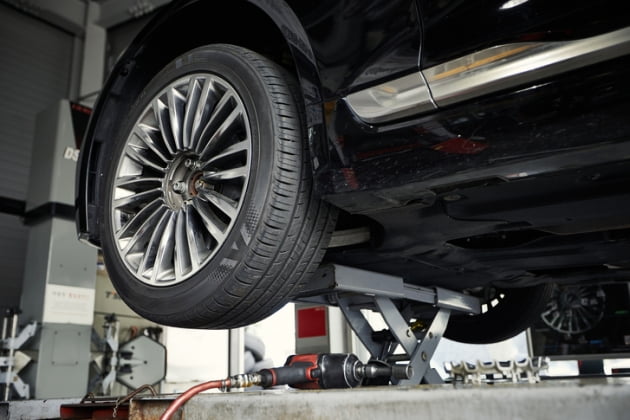
Photo = Getty Image Bank
# Mr. Jo, 30, the owner of the car owner, who entrusted his Mercedes E-class repair to an official service center in a traffic accident earlier last year, waited three months, and eventually had to solve it at a private company. This is a result of the delayed date of reservation for repairs by official service centers. After being notified that they had to wait for about 2-3 weeks due to the supply and demand of parts, the repair was delayed, Mr. Cho said.
He expressed his feelings of displeasure at the time, saying, “I was tired of the answer from the service center repeating the same words and eventually turned to a private company.”
It is the era of 300,000 imported cars. Although the domestic market is growing rapidly, it is pointed out that the level of after-sale service (AS) is still poor. This is because parts prices are still more expensive than domestic cars, and the number of service centers is absolutely insufficient.
According to the automobile industry on the 18th, the imported car market has grown every year except in 2019, which was hit directly by the aftermath of the boycott of Japanese cars. Last year, it recorded an all-time high in the aftermath of the novel coronavirus infection (Corona 19). Last year, the sales volume reached 27,4859 units, an increase of 12.3% from the previous year. This was the result of a combination of individual consumption tax cuts and new car effects.
The share also increased every year. According to the Ministry of Land, Infrastructure and Transport, as of the end of last year, the cumulative number of registered cars was 24.3 million, of which imported cars accounted for 11% of 2.68 million. In addition, the market share of Imports is recording a noticeable rise every year, with 8.4% in 2017, 9.4% in 2018, and 10.2% in 2019.
On the other hand, the number of imported car service centers during the same period is not keeping up with the market growth. Mercedes, which has the largest number of service centers in Korea, is representative.

An imported car service center in Yangjae-dong, Seoul is repairing a flooded vehicle. / Photo = Hankyung DB
Mercedes-Benz, which sold 68861 units in 2017, added seven service centers that year. However, the sales volume of 7,798 units in 2018 and 78,133 units in 2019 increased, but the increase in service centers was only 6 and 4 respectively.
In the last year, the increase was even less. Sales volume remained at 70,6879 units last year, but the number of service centers increased by only three. According to a simple calculation method, the number of service centers increased by 1 per 10,000 units in 2017, but last year it is calculated that the number increased by 1 per 25,000 units.
Even when compared to absolute numbers, it is very inferior to domestic automakers. There are about 545 service centers (as of September 2020) of 20 imported car brands (excluding Chevrolet) registered in the Korea Imported Car Association. Even after reflecting the count, it is estimated to be around 550. This is very low compared to Hyundai Motor and Kia, which have 1385 service centers and 811 service centers, as well as GM Korea, which has 426 service centers.

Benz opened a service center in Yeongdong, Gangwon on the 9th./ Photo = Yonhap News
Of these, Mercedes has a total of 71, with the largest number of service centers among domestic imported car makers. This was followed by 63 BMW and 40 Audi. Volkswagen and Jeep have 35 and 18 service centers, respectively. There are only 12 service centers for Tesla, which sold more than 30,000 models last year.
Even in the provinces, most of them do not have service centers except for major hub cities.
If a problem arises right away, it is often inevitable in the provinces to unwillingly go to private repair centers or general workshops.
Kim Mo, 28, the owner of BMW 520 said, “Recently while on a trip to the South Sea with my boyfriend, I experienced a problem that the vehicle could not achieve a speed of more than 70 km/h on the expressway.” I went to the general repair shop,” he confessed. There was also a period of free repair, but it was an unavoidable choice for Mr. Kim. Kim was concerned about the repair cost bomb, but fortunately, he was relieved that the repair cost was only 50,000 won due to a simple fuse replacement.

Volvo Cars Bundang Service Center./ Photo = Volvo
In this regard, the imported car industry is concentrating on expanding service centers this year. This year, Mercedes plans to expand its service centers nationwide, equipped with charging facilities for the electric vehicle brand’EQ’. In addition, the’AMG Brand Center’, where you can experience the high-performance brand AMG, will be established in Sinsa-dong, Gangnam for the first time in Korea.
Volvo plans to open service centers in five regions this year, including Gimhae, Guri, Seodaegu, Seoul Gangdong, and Gangnam Yulhyeon, and plans to expand and relocate the Ilsan service center to build a total of 33 networks.
However, in light of the recent market growth, the industry’s criticism is expected to be more intense.
An automobile industry official said, “It is not enough to fill the gap with consumer demand only by increasing the number of single digits per year.”
Shin Hyun-ah, Hankyung.com reporter [email protected]
Article reports and press releases [email protected]
